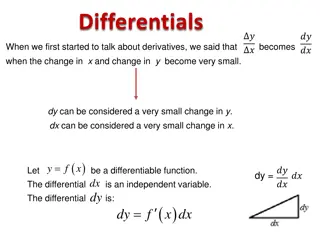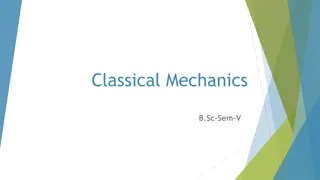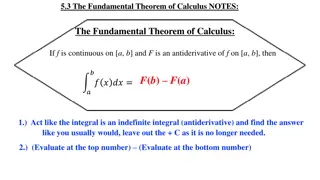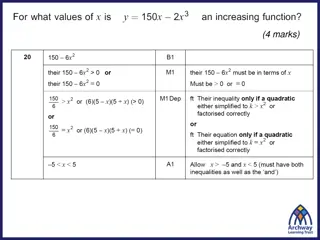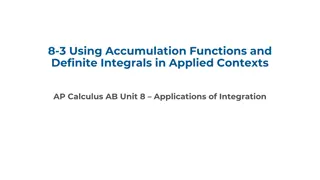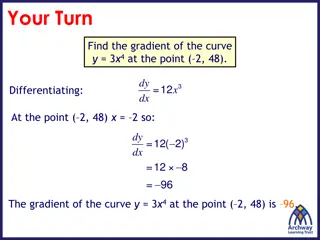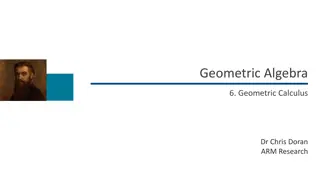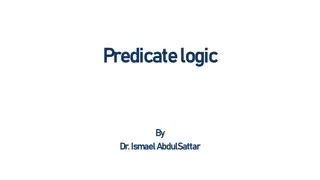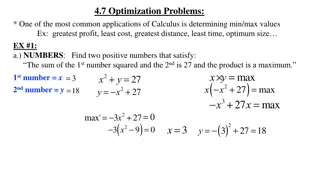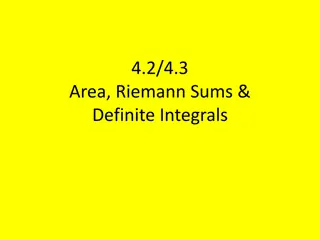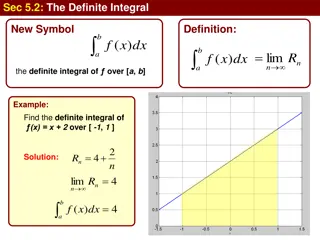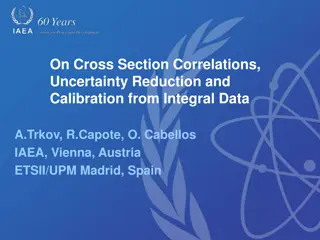Understanding Integral Calculus: Two Major Approaches & Antiderivatives
In this chapter, we delve into the fundamental concepts of integral calculus, focusing on two major approaches to mathematically generate integrals and assigning physical meanings to them. We explore antiderivatives, differentiation, integration, and the process of taking integration as the inverse of differentiation. Through examples and explanations, we aim to provide a clear understanding of integrals and their applications.
Download Presentation

Please find below an Image/Link to download the presentation.
The content on the website is provided AS IS for your information and personal use only. It may not be sold, licensed, or shared on other websites without obtaining consent from the author. Download presentation by click this link. If you encounter any issues during the download, it is possible that the publisher has removed the file from their server.
E N D
Presentation Transcript
INTEGRAL CALCULUS BY SUWARDI
2.1 INTRODUCTION TWO MAJOR APPROACHES ANTIDERIVATIVES to mathematically generate integrals INTEGRATION to assign a physical meaning to the integral The other approach: To consider the integral as the sum of many similar, infinitesimal elements The process of taking integration, as the inverse of differentiation
In this chapter we shall consider the reverse process. Knowing the effect of individual changes, we wish to determine the overall effect of adding together these changes such that sum equals a finite change Before considering the physical significance and the application of integral calculus, let us briefly review the general and special methods of integration
2.2 INTEGRAL AS ANTIDERIVATIVE Function y = f(x), differentiation of this function, symbolized by the equation ( ) dy df x = = = ( ' ) dy f x dx ( ' ) f x dx dx Where f (x) denotes the first derivative of the function f(x) with respect to x
In this chapter we shall pose the following question: What function f(x), when differentiated, yields the function f (x)? For example, what function f(x) when differentiated, yields the function f (x) = 2x? Substituting f (x) = 2x into equation gives dy = = 2 or 2 dy x dx x dx
This function, f(x), for which we are looking is called the integral of the differential and symbolized by the equation = ( ) ( ' ) f x f x dx : the integral sign; f (x): the integrand
If f(x) = 2x, then f(x) = x2. f(x) = x2 is not the complete solution but f(x) = x2 + C is the complete solution. C is the constant of integration, and this constant always is included as part of the answer to any integration. Thus, = = + 2 2 y x dx x C
2.3 GENERAL METHODS OF INTEGRATION Let us consider several general methods of integration = + . 1 ( ) ( ) du x u x C = = + . 2 a du a du au C + 1 n u = + n . 3 u du C + 1 n
Examples: 4 x 4 = + 3 ( ) a x dx C RT RT 1 H H H H H = = = + = + 2 1 ( ) b dT dT T dT T C C 2 2 R T R R
du = = + . 4 ln ln d u u C u + = + . 5 ( ) ( ) ( ) ( ) f x g x dx f x dx g x dx 1 = + mx mx . 6 e dx e C m 1 = + . 7 sin cos kx dx kx C k 1 = + . 8 cos sin x dx x C k
2.4 SPECIAL METHODS OF INTEGRATION Many of the functions encountered in physical chemistry are not in one of the general forms given above Special methods of integration: Algebraic Substitution Trigonometric Transformation Partial Fractions
Algebraic Substitution The mathematical functions can be transformed into one of the general forms in section 2.3 or into one of the forms found in table of integral by some form of algebraic substitution Examples ( 1 2 Evaluate ) ( ) 5 2 . a x x dx
Let us attempt to transform this integral into the form un du Let u = (1 x2), Then du = -2x dx. Hence, ( 1 ) ( 1 ) 1 1 5 6 = = + = + 2 5 6 2 2 x x dx u du u C x C 6 6
kT E / E k T ( ) Evaluate b e dT 2 E E = = Let u Then . Hence du 2dT kT kT kT E = = + = + / / E k T u u E k T e dT e du e C e C 2
dV ( ) Evaluate . c V nb du u Let us attempt to transform the integral into the form . Let u = V nb. Then du = dv. Hence, dV du = = + = + ln ln( ) u C V nb C V nb u
2 ( ) Evaluate sin cos d x x dx Let u = sin x. Then du = cos x dx. Hence 1 1 = = + = + 2 2 3 3 sin cos sin x x dx u du u C x C 3 3
Trigonometric Transformation Many trigonometric integrals can be transformed into a proper form for integration by making some form of trigonometric transformation using trigonometric identities. For example, to evaluate the integral we must make use of the identity 2 sin x dx 1 ( ) x 2 = sin2 1 cos x 2
Thus, 1 1 1 ( ) = 1 cos 2 cos 2 x dx x dx 2 2 2 Integrating each term separatly gives, 1 x 2 = + sin2 sin 2 x dx x C 4
Again, integration of integral of this type are more parctically done by using the Table of Integrals Example: Evaluate 3 cos 2 x dx Integration of this function can be accomplished using integral from the Table of Integral. Here, a = 2 and b = 0 1 1 ( ) ( ) ( ) + = + + + 3 3 cos sin sin ax b dx ax b ax b C 3 a a 1 1 = + 3 3 cos 2 ( ) sin( 2 ) sin 2 ( ) x dx x x C 2 6
Partial Fractions Consider an integral of the type dx , where and are constants a b ( ( ) x ) a b x This type of integral can be trasformed into simpler integral by the following method. Let A = (a x) and B = (b x). Then 1 1 B A B A = = A B AB AB AB
Therefore, 1 1 1 1 = ( ) AB B A A B 1 1 1 1 = ( )( ) ( ) ( ) ( ) a x b x b a a x b x 1 dx dx dx = ( )( ) ( ) ( ) ( ) a x b x b a a x b x Which can be integrated to give, ( ) 1 1 b x dx )( = + + = + ln( ) ln( ) ln a x b x C C ( ) ( ) ( ) ( ) a x b x b a b a a x
2.5 The Integral as a summation of infinitesimally In the previous sections we have considered integration as the purely mathematical operation of finding antiderivatives. Let us now turn to the more physical aspects of integration in order to understand the physical importance of the integral
Consider, as an example: 1. The expansion of an ideal gas from a volume of V1 to a volume V2against a constant external pressure Pext, The plot seen in the indicator diagram is not a graph of Pext as a function of V. There is no functional dependence between the external pressure on the gas and the volume of the gas
The diagram shows what the external pressure is doing on one axis and what the volum is doing on the other axis Both can vary independently The work done by the gas does depend on both the external prssure and the volume change For expansion, the work is w = - Pext(V2 V1) W is just the negative of the area under the Pext versus V diagram
2. The external prssure changes, in some fashion, as the volume changes The external pressure is not changing as a function of volume To emphasize this point, let us assume that the external prsessure actually goes up as the volumes changes (see indicator diagram ) A gas could be expanding against atmospheric pressure which perhaps is increasing over the period of time that the expansion take place
Indicator diagram showing PV work done by a gas expanding against a variable external pressure
The approximate area under the curve, then, is just the sum of the four rectangles 4 = i = + + + = approx A P V P V P V P V i V P 1 2 3 4 1 If we extend this process-that is if we divide the area under the curve into more and more rectangles of smaller and smaller V-the sum approaches a fixed value as N approaches infinity
Hence, we can write N = i lim = A P V i N 1 However, since as N approaches infinity, V approaches zero, we also can write N = i lim = A P V i 0 V 1 But, by definition V N 2 = i V lim V = P V P dV i i 0 1 1
V 2 Where the symbol is read the integral V 1 from V1 to V2 , and V1 and V2 are called the limits of integration. Hence, V 2 This integral is called a definite integral = A P dV ext V 1
2.6 Line Integral Integral of the general type x 2 x = A y dx 1 Are called line integral, because such integral represent the area under the specific curve (path) connecting x1 to x2
Such integral can be evaluated analytically (i.e., by finding the antiderivative) only if an equation, the path, y = f(x) is known, since under these circumstances the integral x 2 x ( ) f x dx 1 contains only one variable
If y is not a function of x (as in the case of Pext versus V), or if y is a function of x, but the equation relating y and x is not known or can not be 2 = ax y e integrated (as in the case ), or
if y is a function of more than one variable that changes with x, then the line integral cannot be evaluated analytically, and one must resort to a graphical or numeric method of integration in order to evaluate the integral.
1. The integral in below can be evaluated analytically if we assume that Pext is a constant, hence, it can be brought out of the integral V V 2 2 = = = ( ) A P dV P dV P V V 2 1 ext ext ext V V 1 1 work = -A = - Pext(V2- V1)
2. A second way to evaluate the above integral is found in the concept of reversibility. If the expansion of the gas is reversible, then for all practical purposes the external is equal to the gas pressure, Pext = Pgas. This gives V V 2 2 V V = = ( , ) A P dV P T V dV ext gas 1 1 It can be integrated if P is a function of V only so T must be constant (isothermal condition)
We can write V V V nRT 2 2 2 = = = A P dV P dV dV ext gas V V V V 1 1 1 V dV 2 ( ) = = ln ln nRT nRT V V 2 1 V V 1 V = ln 2 nRT V 1
Example The change in enthalpy as a function of temperature is given by the equation T 2 = H C dT P T 1 Find the change in enthalpy for one mole of real gas when the temperature of the gas is increased from, say, 298.2 K to 500.0 K
Solution We first recognize that the above integral is a line integral. This integral cannot be evaluated unless CP as a function of T is known We could assume that CP is a constant and evaluate the integral that way, but over such a large temperature range the approximation would be poor Another approach would be to determine the integral numerically
One analytical approach is to expand CP as a power series in temperature CP = a + bT + cT2 The constant a, b, and c are known for many common gases. Substituting this into the H equation gives T 2 1 T = + + 2 ( ) H a bT cT dT b c = + + 2 2 3 3 ( ) ( ) ( ) H a T T T T T T 2 1 2 1 2 1 2 3
2.7 Double and Triple Integrals Functions could be differentited more than once How about the determination of multiple integrals Example, The volume of cylinder is a function of both the radius and the height of the cylinder. That is, V = f(r, h)
Let us suppose that we allow the height of the cylinder, h, to change while holding the radius, r, constant The integral from h = 0 to h = h, then, could be expressed as h 0 ( , ) f r h dh
But the value of this line integral depends on the value of the radius, r, and hence the integral could be considered to be a function of r. h 0 = ( ) ( , ) g r f r h dh If we allow r to vary from r = 0 to r = r and integrate over the change, we can write r r h 0 0 0 = ( ) ( , ) g r dr f r h dh dr
To evaluate the above double integral, we 0 h integrate first while holding r a dh h r f ) , ( constant, which gives us g(r). r Then we integrate next while holding 0 ( ) g r dr h constant. Such a process is known as successive partial integration
r h For example, let us evaluate 0 2 r dh dr 0 h First, 0 = = ( ) 2 2 g r r dh r h Next, we integrate r r 0 0 = = 2 ( ) 2 g r dr rh dr r h That is the volume of a cylinder
The above argument can be extended to the triple integral. For example, let us evaluate the triple 0 0 0 y z x dx dy dz x 0 First, evaluate = dx x Substituting this back into the above equation gives 0 0 y z x dy dz
Next, evaluate y 0 = x dy xy Substituting this back into the above equation gives xy 0 z dz Integrating this gives z 0 = xy dz xyz Which is the volume of a rectangular box x by y by z
Problem. The differential volume element in spherical polar coordinates is dV = r2sin d d dr. Given that goes from 0 to 2 , and r goes from 0 to r, evaluate the triple integral 2 r 0 0 0 = d d 2 sin V r dr Solution 2 0 0 2 d = 4 d = 2 2 2 2 2 sin sin sin r r r r r 4 0 = = 2 3 4 r dr r V 3
PROBLEMS 1. Evaluate the following integral (consider all uppercase letters to be constant): RT 2 ( ) 4 a x dx + 2) 5 ( g) dp ( ) 3 ( d x x dx p 1 ( ) b dx d M x ( ) 4 e e dx ( h) 2 x d ( f ) P ( ) cos 2 ( ) i W t dt ( ) sin 3 c x dx
2. Evaluate the following integrals using the Table of Integral (consider all uppercase letters to be constant): 2 2 / 1 ) 2 4 x ( ) ( e x A dx ( ) a e dx d 3 ( ) cos sin i N x 2 ( ) sin f x dx d + 4 4 2 3 ( ) cos k ( ) ( 2 ) 4 b x x x dx A 2 2 xcos ( ) ( ) ( ) c x A dx g e x dx + 6 ( ) sin 3 ( ) 4 l x dx dx N x ( ) m 2 2 ( ) sin d dx ( ) sin 2 ( ) h Wt dt 4 ( )( 3 ) x x A
3. Evaluate the following definite integrals using the Table of indefinite and definite interals, as needed T d T 2 T H 2 a a bT + + + 2 n x a . a cT dT . d dT 2 2 . sin g x dx 2 RT T 1 T 0 1 P V RT P 2 nRT V n a V 2 2 . b dP . e dV 2 2 ax 2 . h x e dx nb P V 1 1 0 /2 2 2 . sin cos f d . c d 0 0




